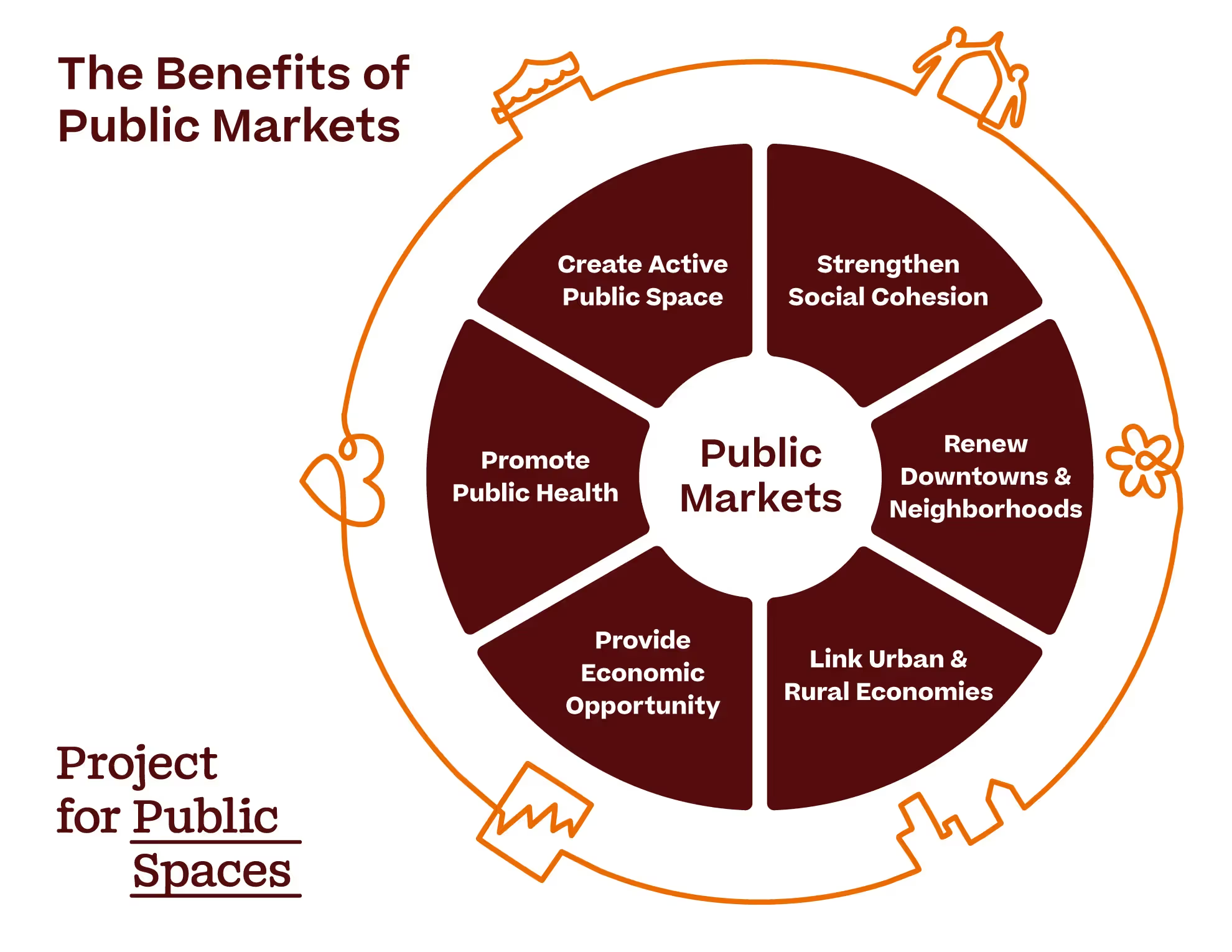A biweekly newsletter with public space news, resources, and opportunities.
A curated dispatch on all things public markets plus the latest announcements from the Market Cities Program.
Editor’s Note: The benefits of public markets, identified by Project for Public Spaces nearly two decades ago, impact all aspects of our communities, including public health, social cohesion, climate resilience, and the ability to make a decent living. Expanding these impacts through the power of public markets is at the heart of the Market Cities Program. — Kelly Verel, Co-Executive Director, Project for Public Spaces
Public markets are as old as civilization. For millennia, cities have shaped and been shaped by public market activity. But what does it mean to be a public market in the twenty-first century? The term “public market” covers all types of markets, including open-air markets, covered markets, permanent market halls, market districts, and even informal markets of street vendors. Public markets can be temporary and seasonal or permanent and in operation 24 hours a day, seven days a week, 365 days a year. Depending on the type of public market, vendors may sell fresh and prepared food or non-food items, such as household goods, crafts, and antiques.
The bustling Middle Eastern souks, grand European market halls, informal African street markets, vibrant Central and South American mercados, and charming North American farmers markets are all types of public markets and they all uniquely contribute to culture and a sense of place.
However, public markets are not just places of commerce. What sets public markets aside from other retail locations is that they operate in public space, serve locally owned & operated businesses, and have public goals. This focus on the public good is what makes successful markets grow and connect urban and rural economies. They encourage community and economic development by keeping money in the local neighborhood. Public markets also offer low-risk business opportunities for vendors, often from vulnerable populations, and depending on the type of public market, they feed money back into the rural economy where farmers grow, raise, and produce their products.
The spin-off benefits of public markets are numerous. From increasing access to fresh, healthy food to providing important revenue streams, markets positively impact local businesses, governments, and residents. But perhaps most importantly, public markets serve as public gathering places for people from different ethnic, cultural, and socioeconomic communities—markets are our neighborhoods’ original civic centers.

Project for Public Spaces, with support from the Ford Foundation, researched the impacts public markets have on their communities. Six of the most prominent impacts are below. These findings helped frame a three-year grant program funded by Ford and the W.K. Kellogg Foundations, and in our ongoing work we continue to see that successful public markets are more than just business enterprises—they are public spaces that shape communities and economies for the better.
Learn more about the benefits of public markets*:
*Resources linked to the six benefits above can also be found in the Market Cities Resource Library.
The rich text element allows you to create and format headings, paragraphs, blockquotes, images, and video all in one place instead of having to add and format them individually. Just double-click and easily create content.
The rich text element allows you to create and format headings, paragraphs, blockquotes, images, and video all in one place instead of having to add and format them individually. Just double-click and easily create content.
Body Text Body Link
The rich text element allows you to create and format headings, paragraphs, blockquotes, images, and video all in one place instead of having to add and format them individually. Just double-click and easily create content.
Here is some highlighted text from the article.




Headings, paragraphs, blockquotes, figures, images, and figure captions can all be styled after a class is added to the rich text element using the "When inside of" nested selector system.
Headings, paragraphs, blockquotes, figures, images, and figure captions can all be styled after a class is added to the rich text element using the "When inside of" nested selector system.
Headings, paragraphs, blockquotes, figures, images, and figure captions can all be styled after a class is added to the rich text element using the "When inside of" nested selector system.

We are committed to access to quality content that advances the placemaking cause—and your support makes that possible. If this article informed, inspired, or helped you, please consider making a quick donation. Every contribution helps!
Project for Public Spaces is a 501(c)(3) tax-exempt organization and your donation is tax-deductible within the guidelines of U.S. law.